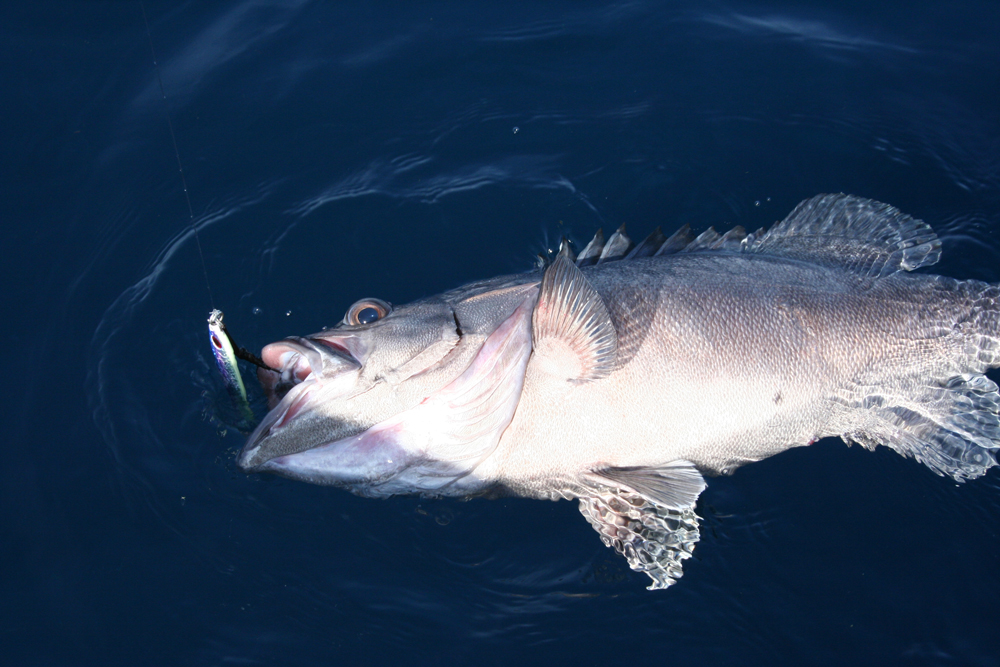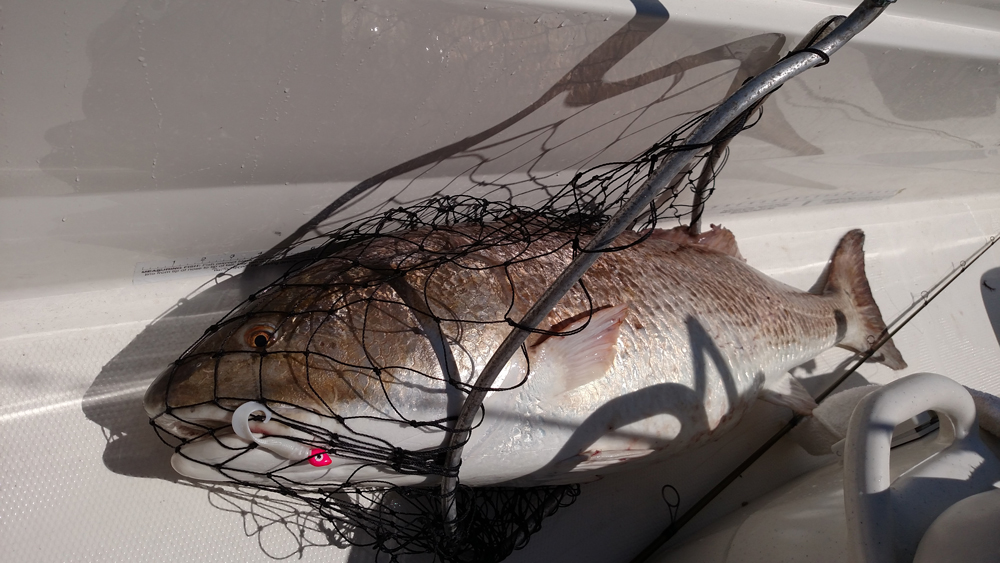7/28/2017 Southern Chesapeake and Virginia Fishing Report:
Rudee Inlet has had a great flounder bite this week, and flounder have also been in the surf along with kingfish, small shark, and bluefish according to Oceans East. Flounder have been taking cut bait and sand fleas, and all the species mentioned have been taking squid and clam. The bayside is holding some rockfish around the Route 60 Bridge, and most are hitting topwater lures or cut baits near bottom. Trollers heading into the ocean are finding plenty of Spanish mackerel plus some snapper blues, all ready and willing to bite on spoons like Drones and Tony Acettas.
Offshore the tuna reports are disappointing, however, white marlin are now being found in better numbers and catches of several in a day are becoming common. Meat-fishermen have mostly taken to deep-dropping for sea bass, tilefish, and the occasional wreckfish.

Bigger news is an influx of large red drum, which have been working their way through the mouth of the Bay and along Virginia Beach. Many of these fish are well over 40-inches, so this is a catch-and-release game (the VA slot limit is 18 to 26 inches). They're being found in schools so multiple hook-ups are in store for anglers casting soft plastics and bucktails dressed with GULP or chunks of peeler crab.
At the CBBT sheepshead are biting for anglers fishing close to the island rocks and bridge pilings with sand fleas. Getting your bait extremely close to the structure has been key. There are also still spadefish and the odd cobia cruising around, and some trigger fish are showing up as well. Bottom fishermen throughout the area are catching a mix of croaker, spot, and kingfish. Kiptopeke, the CBBT, and the areas around the HRBT have all been mentioned as good areas to try, with anglers a bit farther north finding luck in Mobjack Bay.
Tarpon have been sighted on the ocean side near Mockhorn, but getting them to bite can be a challenge. There are also still cobia being found off Kiptopeke and Cape Charles but the bite is tougher now and many of the fish are sub-legal. Chummer are doing a bit better than sight-casters but they also have to contend with lots of sharks.
7/21/2017 Southern Chesapeake and Virginia Fishing Report:
Oceans East let us know that there’s a steady flounder bite bay-side, around Rudee inlet, and the route 60 channel. Flounder are taking small lures and cut bait such as sea clam, bunker, and also sand fleas. Fish Bites are also working for some anglers. Lots of Spanish mackerel and a few blues make up the catch for trollers pulling spoons near shore. Anglers venturing to the Light Tower, near-shore wrecks, and the CBBT with clams aboard have discovered a good spadefish bite is now another option. Chum by smacking the clam together and letting the juices, bits, and pieces drip into the water, and bait up with small slivers of clam. Remember that this species has an extremely small mouth for its size, and you want to use a small hook (a #1 is plenty big) and a small bit of clam drifted back in the chum line with little or even no weight.

Sight fishing for cobia inside the bay has calmed down somewhat, but is still a decent option. Many of the cobia now being caught are just under legal size or are barely-legals. Some have also been found around the CBBT. The CBBT islands are also holding lots of sheepshead, a species which seems to be making a significant come-back in our region. Anglers targeting them in specific are doing best with sand fleas fished very close to the structure.
The surf is holding solid numbers of kingfish, bluefish, and small shark that are hitting cut bait, sand fleas, clam, and squid. Chesapeake Bait and Tackle reported a strong wreck bite, and that sea bass have been hanging around the wrecks in large numbers. Sea bass have been taking peeler crab and clam.
7/14/2017 Southern Chesapeake and Virginia Fishing Report:
Oceans East reports that flounder are biting well in the inlet and in back bay channels, as well as around the Route 60 Bridge. Most flounder are biting gudgeon, minnows, and lures bounced off bottom. The inlet and Route 60 Bridge are also holding sheepshead, which are biting best on sand fleas.
Boats headed through the inlet are finding plenty of Spanish mackerel with some bluefish mixed in while trolling near shore. Those continuing farther out have found some bluefin up into the 60-inch range. The canyons are producing some yellowfin to 50 pounds, but the past week wasn't "red hot" for numbers and most boats returned to the dock with one to three fish plus mahi.
Bluefish have been in the surf on both bay and ocean side, however not in the numbers that they were before, as many have moved up north. Small sand sharks and kingfish are being caught in the surf, in addition to the bluefish. The kingfish are taking bloodworm and sandfleas.
Crabbing in the back bay has been excellent, and many guys crabbing are coming come with bushel baskets full.
The lower Bay cobia bite has settled into a normal summer pattern, with the fish a bit less concentrated and lower number than we saw a few weeks ago, but sight fishermen are still getting in plenty of shots and chummers can expect a few bites to come at the end of the tide. Bring extra hooks, leader, eels and bunker, because sharks are numerous and problematic for the chummers.
7/7/2017 South Chesapeake and Virginia Fishing Report:
Rudee Inlet and the Route 60 bridge have held large numbers of puppy drum as July started, with kingfish and flounder mixed in. Although the bluefish bite has died down from what is was in early to mid June, some bluefish are still being caught too, however most are smaller than in previous weeks. Kingfish are being caught around the bridge as well as in the surf, and are hitting cut squid and sand fleas.
The surf bite has also included some small black drum, flounder, and croaker. The flounder bite on bayside has been good, and most boats are bringing home dinner. Flounder are hitting white Gulp lures and minnow. Fishing Oceanside from shore, anglers using finger mullet have been catching bluefish and small sharks, making for an interesting evening of fishing.
Offshore, most boats travelling to the canyons are reporting a mix of yellowfin tunas and mahi-mahi. There seem to be good numbers of both species around right now, but the bite is on-again, off-again. Inshore lumps have produced a few bluefin and closer to the beach, an influx of good numbers of Spanish Mackerel is the big news. Anglers trolling small spoons have been catching them by the dozen in some cases, with a few bluefish usually mixed into the catch.
In the southernmost portions of the Chesapeake cobia fishing has cooled off a bit as the fish have scattered more and more, though there are still plenty around for both sight-fishers and chummers to target them. Lots of shark are mixed into the catch for chummers, so come prepared with plenty of extra hooks and be ready to sort through the toothy critters as you wait for the cobia bite (which is usually coming on the end of the tide). Flounder anglers are also doing well, both at the CBBT and also along the Bay drop-offs and ledges. There are also some red drum showing up around the CBBT. Keep your eyes peeled for the August edition of FishTalk, in which we have a feature article written by local sharpie Chuck Harrison. Here's a short sneak-peek preview:
Both red and black drum swim along the sides of the islands during the summer. There is a place along the side of the second island where I usually start. Look for a pile of rubble rising from 20 feet to 10 feet. I have caught reds there from 25 to 44 inches on jigs. I have also caught black drum there in the same size range. The key, particularly for the reds, is moving water. Jig size and color don’t seem to make much difference. The largest red I have caught (about 50 pounds) was on a half-ounce jig with a four-inch Gulp swimming mullet. Elephants do eat peanuts.
If you don’t find the fish immediately, drift down the side of the island staying 30 feet from the rocks. Keep one eye on the fish finder. There will be many marks since spadefish, triggerfish, small sea bass, and blues inhabit the same area. The distinct marks of the larger fish will stand out from the others. Both types of drum often swim around in schools a few feet from the surface. At times it is easy to spot the school, so keep your other eye on the water. If you’re marking fish but not getting bites, try a live bait. I always put a few spot or croakers in the live well first thing in the morning. Either will work for red drum, or for the odd cobia that swims by.

Inside the mouth of the Bay, bottom fishermen are reporting good numbers of kingfish (sea mullet) biting on bloodworms, along with croaker, some surprisingly nice spot, and a very few weakfish. Those focusing on Mobjack Bay have encountered some speckled trout, flounder, and also a few stripers.